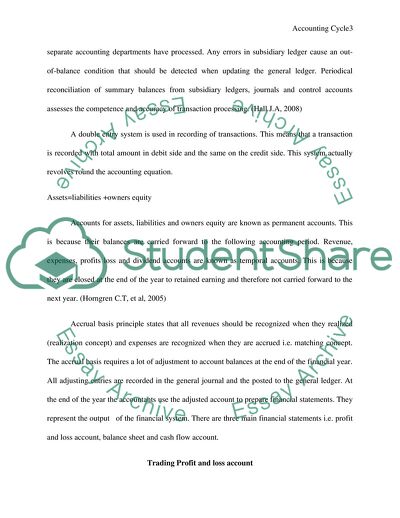
- Home
- Free Samples
- Premium Essays
- Editing Services
- Extra Tools
- Essay Writing Help
- About Us
- Studentshare
- Subjects
- Miscellaneous
- Accounting Cycle Paper
Accounting Cycle Paper - Essay Example

- Subject: Miscellaneous
- Type: Essay
- Level: Masters
- Pages: 4 (1000 words)
- Downloads: 0
- Author: nicolasraegan
Extract of sample "Accounting Cycle Paper"
All transactions must be recorded in journals. There are many types of journals, for example, sales journal, purchases journal, return inwards journal, return outwards journal and general journal. Transactions that do not fit in any other special journal are recorded in a general journal. All transactions recorded in a journal are called journal entries. At the end of the year all transactions in journals are posted to a general ledger. This is a group of accounts for a company. The account summarizes the information from the journals.
They store the monetary information of a company. The accounts include cash account, debtors account, creditors account. Due to the fact they contain summarized information make them sufficient for reporting purposes, but they are not useful for supporting daily business operations. Apart from the general ledger the company keeps subsidiary ledgers. They are kept in different accounting departments of a firm. They include inventory account, account payable, pay roll, and account receivable. The separation provides better control the business operations.
Apart from subsidiary ledger providing financial statements with information, they also act as general ledger verification mechanism. They verify the accuracy of the accounting data that the separate accounting departments have processed. Any errors in subsidiary ledger cause an out-of-balance condition that should be detected when updating the general ledger. Periodical reconciliation of summary balances from subsidiary ledgers, journals and control accounts assesses the competence and accuracy of transaction processing. (Hall J.A, 2008) A double entry system is used in recording of transactions.
This means that a transaction is recorded with total amount in debit side and the same on the credit side. This system actually revolves round the accounting equation. Accounts for assets, liabilities and owners equity are known as permanent
...Download file to see next pages Read MoreCHECK THESE SAMPLES OF Accounting Cycle Paper
The Payroll and Personnel Cycle
The Accounting Cycle Steps
Finance and Accounting for Business
Accounting Cycle Description
Emerging Technologies in Accounting
Integrated Accounting Cycle in Riordan Manufacturing
Growing Adoption of Green Accounting at Corporate and Macroeconomic Level
4-part Financial Accounting

- TERMS & CONDITIONS
- PRIVACY POLICY
- COOKIES POLICY